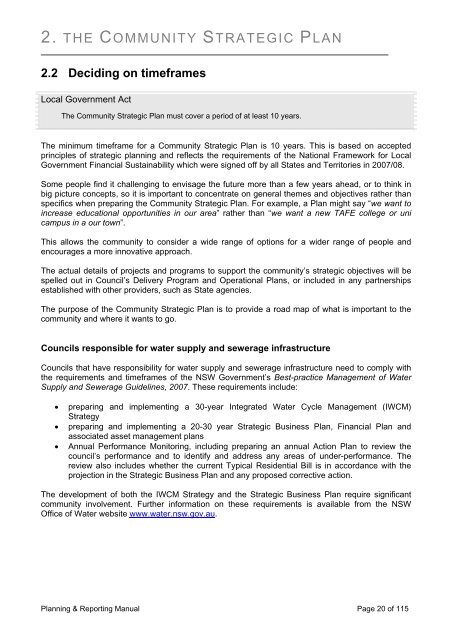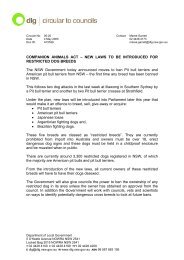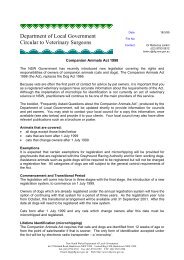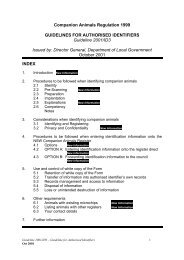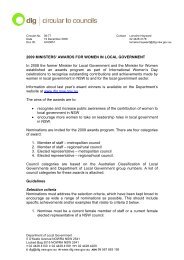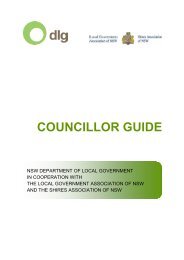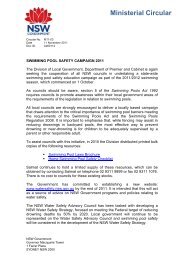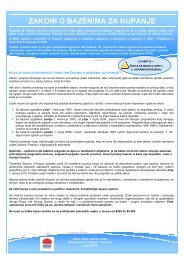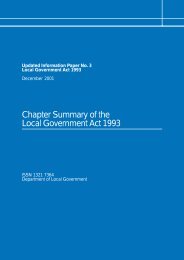Integrated Planning and Reporting Manual - Division of Local ...
Integrated Planning and Reporting Manual - Division of Local ...
Integrated Planning and Reporting Manual - Division of Local ...
You also want an ePaper? Increase the reach of your titles
YUMPU automatically turns print PDFs into web optimized ePapers that Google loves.
2. THE COMMUNITY STRATEGIC PLAN<br />
2.2 Deciding on timeframes<br />
<strong>Local</strong> Government Act<br />
The Community Strategic Plan must cover a period <strong>of</strong> at least 10 years.<br />
The minimum timeframe for a Community Strategic Plan is 10 years. This is based on accepted<br />
principles <strong>of</strong> strategic planning <strong>and</strong> reflects the requirements <strong>of</strong> the National Framework for <strong>Local</strong><br />
Government Financial Sustainability which were signed <strong>of</strong>f by all States <strong>and</strong> Territories in 2007/08.<br />
Some people find it challenging to envisage the future more than a few years ahead, or to think in<br />
big picture concepts, so it is important to concentrate on general themes <strong>and</strong> objectives rather than<br />
specifics when preparing the Community Strategic Plan. For example, a Plan might say “we want to<br />
increase educational opportunities in our area” rather than “we want a new TAFE college or uni<br />
campus in a our town”.<br />
This allows the community to consider a wide range <strong>of</strong> options for a wider range <strong>of</strong> people <strong>and</strong><br />
encourages a more innovative approach.<br />
The actual details <strong>of</strong> projects <strong>and</strong> programs to support the community’s strategic objectives will be<br />
spelled out in Council’s Delivery Program <strong>and</strong> Operational Plans, or included in any partnerships<br />
established with other providers, such as State agencies.<br />
The purpose <strong>of</strong> the Community Strategic Plan is to provide a road map <strong>of</strong> what is important to the<br />
community <strong>and</strong> where it wants to go.<br />
Councils responsible for water supply <strong>and</strong> sewerage infrastructure<br />
Councils that have responsibility for water supply <strong>and</strong> sewerage infrastructure need to comply with<br />
the requirements <strong>and</strong> timeframes <strong>of</strong> the NSW Government’s Best-practice Management <strong>of</strong> Water<br />
Supply <strong>and</strong> Sewerage Guidelines, 2007. These requirements include:<br />
preparing <strong>and</strong> implementing a 30-year <strong>Integrated</strong> Water Cycle Management (IWCM)<br />
Strategy<br />
preparing <strong>and</strong> implementing a 20-30 year Strategic Business Plan, Financial Plan <strong>and</strong><br />
associated asset management plans<br />
Annual Performance Monitoring, including preparing an annual Action Plan to review the<br />
council’s performance <strong>and</strong> to identify <strong>and</strong> address any areas <strong>of</strong> under-performance. The<br />
review also includes whether the current Typical Residential Bill is in accordance with the<br />
projection in the Strategic Business Plan <strong>and</strong> any proposed corrective action.<br />
The development <strong>of</strong> both the IWCM Strategy <strong>and</strong> the Strategic Business Plan require significant<br />
community involvement. Further information on these requirements is available from the NSW<br />
Office <strong>of</strong> Water website www.water.nsw.gov.au.<br />
<strong>Planning</strong> & <strong>Reporting</strong> <strong>Manual</strong> Page 20 <strong>of</strong> 115


